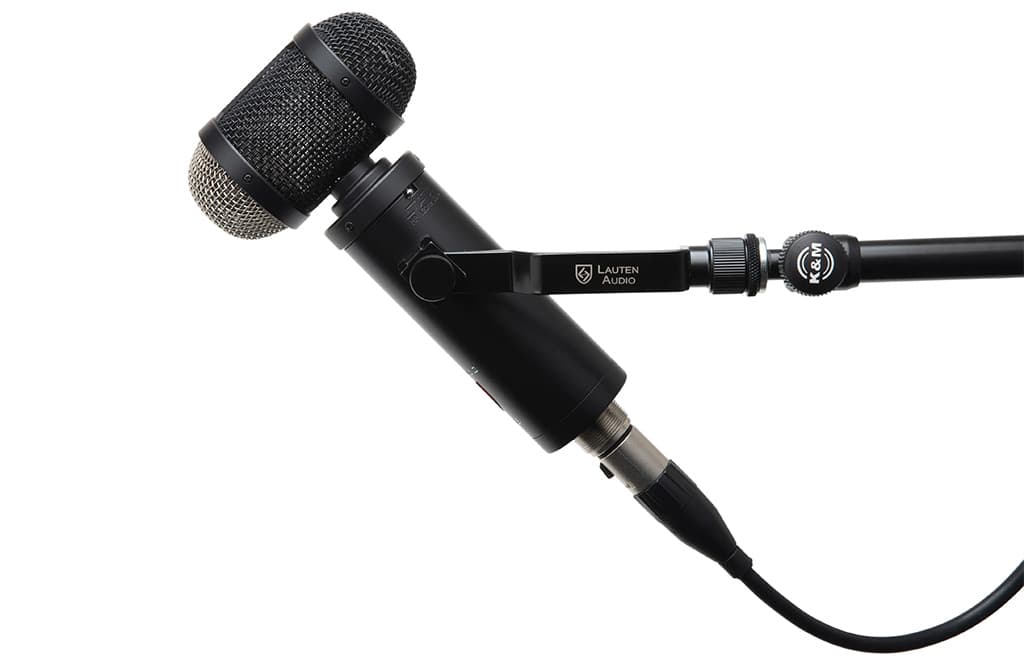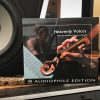
Review: Lauten Audio LS-308
Unique isolation properties, voicing and aesthetics could make the Lauten Audio LS-308 your favourite ‘flavour mic’ on a variety of instruments.
Lauten Audio is a family-owned Californian manufacturer of top-shelf studio microphones. I’m reviewing the LS-308; one of two models in Lauten’s ‘Synergy’ range designed for “studio quality sonics in places where isolation is needed, but difficult to achieve.” It’s a side address FET condenser that probably looks (or sounds) nothing like any other side address mic you’ve encountered.
Although it’s a condenser (which typically means higher sensitivity and greater pronouncement of room reflections) the LS-308 is touted for its ability to isolate sources and reject unwanted bleed. The polar pattern diagram shows a very tight ‘second-order cardioid’ pickup with three small nodes in the rear. Tighter rejection is more typical of a dynamic mic but I understand why it’s a coveted characteristic in a condenser.
Recording in opulent studios smothered with expensive acoustic treatment is a rare luxury for many. The reality is more and more music nowadays comes from converted bedrooms and garages with the kind of acoustics you don’t want flaunted in recorded tracks. So it makes perfect sense that Lauten Audio would zone in on the LS-308’s inherent ability to ignore cheap and trashy room reflections as a way of making the microphone more attractive to home studio owners who want the added clarity and detail of a condenser mic over a dynamic.
GET LOUD
With an SPL handling of 135dB, the LS-308 isn’t afraid of loud noises. Stick it on a snare drum, in front of a Marshall stack or in the bell of a trumpet and it’ll be just fine. And it doesn’t just look like a hammer, it feels like one too. The black matte metal construction has no sign of cut corners and the engraved Lauten Audio name and inset red shield present very smartly. I only wish the embossed numerals denoting the HPF and LPF settings were more pronounced.
Frequency response extends from 20Hz to 20kHz but the rejection characteristics cause the highs to roll off fairly heavily from 4kHz. The LS-308 doesn’t win any awards for a 15dBA self noise spec but if you’re using it primarily on loud sources, that hardly matters. I did notice the noise floor poking through when recording fingerpicked guitar and soft vocals, especially after compression.
Lauten Audio supplies the LS-308 with both a one-armed yoke mount and a ring mount which screws into the base. Between the two, you’re all set to nimbly position it practically anywhere; squeezing into a tight space between gobos, upside down to mic a guitar amp on the floor, angling it down onto a tom or up under a snare drum, up high as a drum overhead, under the lid of a grand piano, etc. I generally preferred using the ring mount because it allows the mic to face perpendicular to the stand’s arm, which is how I tend to position mics a lot of the time especially for a vocalist who’s also playing an instrument. The mic ships in a moulded flight case with a foam windshield.
NEED TO KNOW
Lauten Audio LS-308
Condenser Microphone
I made several recordings in an untreated, boxy-sounding room in my house but with the LS-308 you’d never know

DARK BY DESIGN
A mic’s performance on acoustic guitar is always telling. The first time I plugged the LS-308 in was to record my Martin acoustic. A deep, warm and rich tone leapt from my monitors upon playback of the first test recording, which I put little effort into as far as mic positioning goes – about 15cm pointing off axis at the twelfth fret. My immediate impression was that it sounded like a ribbon microphone with a characterful and understated top end, yet without lacking detail. I’ve recorded my guitar through many, many microphones over the years, but I genuinely think the LS-308 produced the most instantly pleasing recorded tone I’ve ever heard.
I’ll admit that could be because I’m a little tired of super-bright acoustic guitar recordings. My next favourite acoustic guitar option is a Royer R-10 ribbon mic, and that’s saying something of the Lauten. Don’t expect sizzling highs or lots of ‘air’ from the LS-308 – it’s a dark sounding mic. You’ll see the pronounced downward slope from 4kHz plunges steeply at 15kHz. That’s the tradeoff for superior isolation characteristics.
Partly for this reason, the LS-308 favours low end – I’d even go as far to say ‘bass heavy’ – and it pays to be conscious of its proclivity to emphasise rumbly frequencies when tracking certain instruments. For example, I couldn’t place it anywhere near the soundhole of my acoustic guitar or else pounding lows would hijack the recording. Vocals too – a mild plosive easily overwhelms the capsule.
BASS-IC TRAITS
Of course, this low-end leaning can be taken advantage of, which for me, led to exceptional results. I poked it into the soundhole of a cajon to catch as much boom as possible. The Lauten didn’t disappoint, yielding smooth and tight sub-rattling bass which was a perfect complement to the dynamic mic I aimed at the snare wires end of the cajon.
The same effect worked a treat on the high gain channel of a small tube amp. Thanks to the diminished high end, all that nasty fizz that can ruin a distortion guitar tone was outright ignored and instead I ended up with a flattering, chug-happy tone that made the amp sound deceptively beefier than it really is.
In all cases where I didn’t want sub frequencies (i.e. most of the time), I kept the mic’s high pass filter engaged on the 120Hz setting although there’s a 50Hz option too. Two low-pass filters at 8kHz and 10kHz give you more options which are handy when tracking extra bright sources like strings, cymbals or wind instruments. I find it interesting that Lauten Audio built these LPFs into the LS-308, essentially to make an already dark mic sound even darker. A high shelf boost may have made the mic more versatile. But it shows Lauten is secure in their decision to make the LS-308 more of a niche product rather than a jack of all trades.
In all my tests, the mic’s isolation properties were evident. I made several recordings in an untreated, boxy-sounding room in my house but with the LS-308 you’d never know. The value of this extends all the way from untreated home studio rooms to live recordings with a full band to sessions on location.

FIT THE ROLE
On vocals, the Lauten Audio LS-308 produces a warm tone not dissimilar to a dynamic podcasting microphone like a Shure SM7B or EV RE20. The big low end gives a broadcast-y vibe to spoken word while harsh sibilance and gritty trebles are tamed by the capsule’s inherently muted high end. As mentioned, the mic is incredibly prone to plosives so I highly recommend using a quality pop filter for any voice recording application. Be aware, the lack of highs can make a voice sound woolly and dead when unprocessed. Only after a substantial 8-12dB high-shelf boost around 12kHz did the high end begin to match the sound of some of my other mics. After a few weeks with the LS-308, I arrived at the conclusion that its forte is on instruments rather than vocals.
We all love our ‘Swiss army knife’ mics but the LS-308 isn’t meant to be one – it’s a ‘match the tool to the job’ mic. It excels on bright sources that risk sounding thin and brittle when captured by more conventional condensers. In a live recording scenario, the LS-308 will impressively reject bleed from around the room. And that bold bass response will give your subwoofer a workout on kicks and bass amps. Solid build quality and good manoeuvrability set it up for success in the tracking room. From bedroom recordists to studio professionals, the Lauten Audio LS-308 will be a terrific addition to the mic collection.
























RESPONSES